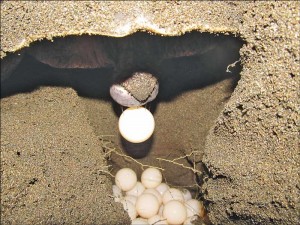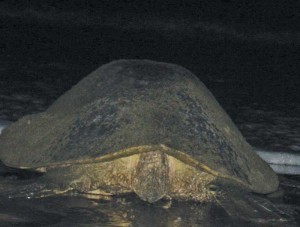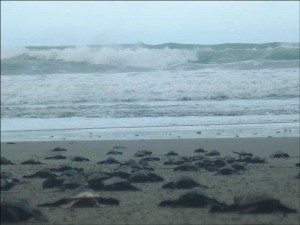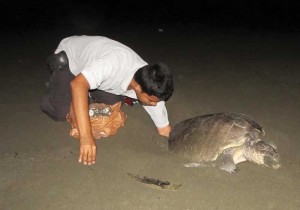Poor Man’s Viagra: The Plight of Our Marine Turtles
The date was August 16, 2013, the time 4:30 PM. Steve and Peggy Sue watched as the bulky form emerged from the shallow waves and began dragging itself up on the moist sand of Barú Beach. It was a strange sight to behold, especially in the afternoon. Olive Ridley Marine Turtles (Lepidochelys olivacea) don’t normally come out of the sea and lay their eggs during daylight hours. In fact, they normally steer clear of the moonlight, only appearing on the beach when the night is pitch black. But here she was, in all her glory, awkwardly pulling herself up on the beach with flippers that looked better suited for maneuvering around in the sea than dragging one hundred pounds of dead weight across the sand. When she reached a point where thousands of years of accumulated instinct told her that the beach looked right, the female began to dig with paddle-like rear flippers. The digging continued until she could reach no deeper. After positioning her backside over the hole she began to expel the flexible, white, leathery spheres shrouded in thick mucous, each about the size and shape of a golf ball. The eggs plopped into the hole one by one until no more remained inside of the reptile. The female began scooping the sand back into the hole covering the precious eggs that would assure the future of her species. She positioned her hard bony underplate over the mound of sand and using her flippers, raised her heavy body into the air and quickly let it fall with a resounding thud, repeating the process until the nest was firmly packed. Near exhaustion, the female Olive Ridley Turtle began her labored trek back to the water’s edge, stopping frequently to rest, until at last she was swallowed by the vastness of the sea. Noticing the encroaching darkness, Steve glanced at his watch. The time was 5:30 PM. “We’d better get back to the lodge,” he said. “Nightfall comes quickly in the tropics.”
 For many thousands of years this scene has been played out upon hundreds of beaches with millions of turtles of many different species. Later come the coyotes, raccoons, coatis, and peccaries to dig out the nutritious white blobs. The ever present and persistent ants take their toll. In some places jaguars kill the adult turtles and eat them, and pumas hunt all of the animals mentioned above that come for the turtle eggs. Depending on the weather and temperature, the eggs that escape the predators hatch sometime between 45 to 60 days later. The hatchlings drag themselves out of the nest hole and up onto the beach, zero in on the movement of the waves, and begin walking toward the surf. The first to hatch are usually able to evade the crabs waiting in ambush and traverse the 30 meters (100 feet) or so to the water. Next they must evade the many species of marine creatures waiting to gobble them up. But after those first few a passing hawk, frigate bird or vulture will spot one of the hatchlings and swoop down to snatch it up. Other birds follow. All of the mammals noted above and even the white-faced capuchin monkeys sometimes take part in the feast. Almost none of the remaining hatchlings survive. Maybe as many as five of the original hundred tiny turtles, each less than half the size of a hockey puck, succeed in entering the sea. With luck one female from every ten nests will grow to maturity and return to lay her eggs on the same beach ten to twelve years later. What she does in the mean time, nobody knows for sure.
For many thousands of years this scene has been played out upon hundreds of beaches with millions of turtles of many different species. Later come the coyotes, raccoons, coatis, and peccaries to dig out the nutritious white blobs. The ever present and persistent ants take their toll. In some places jaguars kill the adult turtles and eat them, and pumas hunt all of the animals mentioned above that come for the turtle eggs. Depending on the weather and temperature, the eggs that escape the predators hatch sometime between 45 to 60 days later. The hatchlings drag themselves out of the nest hole and up onto the beach, zero in on the movement of the waves, and begin walking toward the surf. The first to hatch are usually able to evade the crabs waiting in ambush and traverse the 30 meters (100 feet) or so to the water. Next they must evade the many species of marine creatures waiting to gobble them up. But after those first few a passing hawk, frigate bird or vulture will spot one of the hatchlings and swoop down to snatch it up. Other birds follow. All of the mammals noted above and even the white-faced capuchin monkeys sometimes take part in the feast. Almost none of the remaining hatchlings survive. Maybe as many as five of the original hundred tiny turtles, each less than half the size of a hockey puck, succeed in entering the sea. With luck one female from every ten nests will grow to maturity and return to lay her eggs on the same beach ten to twelve years later. What she does in the mean time, nobody knows for sure.
That was when things happened naturally, before the arrival of Homo sapiens on the scene as a primary actor in the process. Now, maybe one nest in a hundred has the opportunity to hatch naturally. Human poachers efficiently detect and remove all of the eggs before any other predators find the nest. Few nests escape their careful search. The eggs in one nest can be sold to a local cantina for $50 to $60, more than the poacher could make working eight hours a day at an honest job. In the cantina the eggs are opened and dropped into a glass; tomato sauce, lemon juice, Tabasco and rum are added, and the whole mess is swallowed raw. It is considered the “manly” thing to do. Most cantinas call the drink “Poor Man’s Viagra”. The truth is that scientific evidence shows that any effect on sexual potency is purely psychosomatic. The tragedy is that this myth could eventually bring about the demise of the marine turtles.
When Steve and Peggy Sue returned to their cabin at Hacienda Barú Lodge, they stopped by the reception office and told me about their extraordinary experience. I called Felix, the head park ranger, and told him about the strange incident. He told me that in all the years he had worked with marine turtles he had never seen or heard of a female laying her eggs during daylight hours. After the phone call, Felix headed for the location the people had described to me. He soon came across the caterpillar-like tracks left in the sand by the female turtle and followed them to the nest. Probing carefully with a stick, he quickly located the chamber where the eggs rested. With bare hands, Felix dug into the sand until the eggs came into view. He measured the distance from the surface at 17 cm (6.5 inches) and carefully recorded it in a small notebook. Next he donned a pair of latex gloves, retrieved the eggs one by one, counted and carefully placed them in a clean plastic bag. There were only 36 eggs in the nest, the smallest so far this year. This was probably the first laying of this particular female. That could explain her strange behavior, coming out of the sea in the afternoon, he surmised. Felix measured the depth and diameter of the nest. The chamber was considerably smaller than normal, the average being 22 cm (8.5 inches) to the first eggs, 38 cm (14.6 inches) in total depth, and 30 cm (11.5 inches) in diameter. After making the notations in his little book, Felix walked back to the ranger station where Hacienda Barú has kept a turtle hatchery since 1984.
 When Felix reached the hatchery, he first located the site for the next nest. Next, he dug a hole with the same dimensions as the one from which he had retrieved the eggs; 32 cm (12.3 inches) deep and 24 cm (9.2 inches) in diameter. He then laid the eggs carefully in the hole. Finally he covered the eggs with sand which he packed to the same firmness as the nest on the beach. There they would rest for a period of 51 days on average. There were already 36 nests in the nursery. After five days the nest would be marked with a number and date. Previously they had marked each nest immediately after planting the eggs. One night when the rangers were out patrolling the beach, some poachers raided the hatchery and stole the three most recent nests, those that were fresh enough so the eggs could still be consumed.
When Felix reached the hatchery, he first located the site for the next nest. Next, he dug a hole with the same dimensions as the one from which he had retrieved the eggs; 32 cm (12.3 inches) deep and 24 cm (9.2 inches) in diameter. He then laid the eggs carefully in the hole. Finally he covered the eggs with sand which he packed to the same firmness as the nest on the beach. There they would rest for a period of 51 days on average. There were already 36 nests in the nursery. After five days the nest would be marked with a number and date. Previously they had marked each nest immediately after planting the eggs. One night when the rangers were out patrolling the beach, some poachers raided the hatchery and stole the three most recent nests, those that were fresh enough so the eggs could still be consumed.
Back in the ranger station, Felix transferred all of the information in his notebook to a ledger which was locked in a drawer in his desk. A couple of times a week, Ronald, the coordinator for the Hacienda Barú turtle project, would stop by and retrieve the updated information, take it back to the office, and tabulate everything on the computer. Once a month a marine biologist visited the site to inspect the hatchery, check the records, and offer suggestions.
Felix checked back to see if any nests were due to hatch soon. The third nest of the year had been found on June 26, and was due to hatch any day now. A small depression had appeared over the nest on the previous afternoon; this meant the first turtles in the nest were starting to break through their shells and would begin emerging onto the sand approximately 36 hours later. That would be tomorrow morning.
Felix retrieved his cell phone from his pocket and made a couple of calls. The first to Ronald, in case some local school children wanted to observe the liberation of the hatchlings and the second to the Hacienda Barú Lodge office. I notified Steve and Peggy Sue as well as the other guests. Anybody who wanted to see the baby turtles needed to be at the beach at 6:00 AM the following morning.
 Some people have suggested that we should carry the hatchlings into the water and even take them out past the breaking waves before releasing them, thereby eliminating a great deal of effort on their part and hopefully enhancing their survival rate. Nevertheless, marine biologists believe that walking across the beach and entering the water is essential to the well being of the young turtles. Apparently a small sample of sea water and sand enters a tiny organ near the nostril and remains there for the life of the turtle. An identical organ on the other side remains empty. According to the theory, ten to twelve years later, when the female turtles return to the beach to lay, they are able to find the exact location on the beach where they entered the water by comparing samples of sea water with the sample taken when they first entered the water as hatchlings.
Some people have suggested that we should carry the hatchlings into the water and even take them out past the breaking waves before releasing them, thereby eliminating a great deal of effort on their part and hopefully enhancing their survival rate. Nevertheless, marine biologists believe that walking across the beach and entering the water is essential to the well being of the young turtles. Apparently a small sample of sea water and sand enters a tiny organ near the nostril and remains there for the life of the turtle. An identical organ on the other side remains empty. According to the theory, ten to twelve years later, when the female turtles return to the beach to lay, they are able to find the exact location on the beach where they entered the water by comparing samples of sea water with the sample taken when they first entered the water as hatchlings.
A small group of people watched as Felix released the hatchlings. Each person was allowed to hold a small turtle in their hand and set it on the sand. The observers were cautioned to remain behind the hatchlings which will walk toward the first movement they see. Mother Nature wants them to hone in on the surf, which is the correct direction to walk. Extraneous movement confuses them. Once on the beach and focused on the breaking waves, the babies use their tiny flippers to scoot across the sand. Each has a yolk sac which contains enough sustenance to get them through the ordeal and into the sea where they will hopefully find plankton, their basic food at this stage in life. If they don’t find food before expending the entire contents of the yolk sac they die. Later in life they will diversify consuming a variety of sea life, including jellyfish.
Steve and Peggy Sue were lucky. Many people walk up and down the beach at night for hours and never see a turtle. There are, however, certain times when you are more likely to see turtles than others. The Olive Ridley marine turtles begin laying eggs on Barú Beach in late June of each year. August and September are the months when most of the eggs are laid. The laying continues at a slower rate through the month of October and dwindles down to nothing in November. Very few turtles come onto the beach during the week of the full moon, and seem to time their egg laying to the rest of the month. They have an uncanny sense that tells them what time of night the moon will rise and set, because they are seldom seen on the beach in the moonlight. Seeing baby turtles is a little easier. The big hatching season is late September through early November when turtles hatch and are released several times each week.
Over the years, with advice from marine biologists, the Hacienda Barú park rangers have refined the handling and recording procedures used in the marine turtle rescue project. Over the last eleven years an average of 81 baby turtles have been successfully released into the sea for every 100 eggs acquired. This amounts to over 75,000 hatchlings liberated since the year 2000. Hacienda Barú has also exchanged information with the nursery at Matapalo Beach, about 12 km northwest of Barú Beach and Playa Tortuga, 50 km south.
The first hatchery on Barú Beach was a project of the owners and employees of Hacienda Barú initiated in the year 1984.
Many people ask to accompany the park rangers on their patrols in the hope of seeing a turtle laying her eggs, and many who have done this have seen turtles. Occasionally you will walk several kilometers in the dark and the rain for hours and not see anything. For people who go on these walks with the rangers we remind you that this project is funded entirely with private donations and strongly suggest that each participant make a donation of $15 all of which will be used to offset the operational costs of the project. Anything you can give will be greatly appreciated. Arrangements for the beach patrol can be made through the Hacienda Barú reception office.


